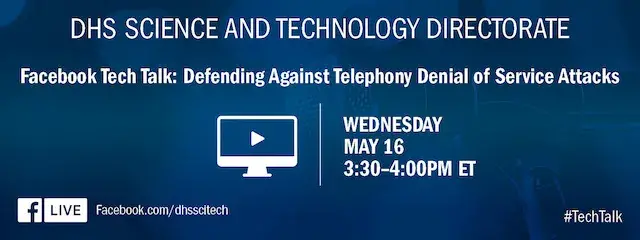Telephony Denial of Service (TDoS) attacks target and often render inoperable critical voice communications systems like 911 emergency operations centers. On May 16 at 3:30 p.m. ET, join the DHS Science and Technology Directorate (S&T) for a Tech Talk dedicated to better understanding these attacks and discussing new ways to counter them.
DHS S&T is engaged in several efforts to improve security for all voice call systems through our cybersecurity research and development program, which researches methods for countering more complex and sophisticated types of TDoS attacks. This research also addresses issues in critical 911 and Next Generation 911 (NG 911) environments.
S&T’s Distributed Denial of Service Defense programs manager Ann Cox and partner Mark Collier, an expert from SecureLogix, will be on hand at the May 16 Tech Talk to explain TDoS attacks, discuss research efforts to counter these types of denial of service attacks and answer your questions.
Government, 911 and enterprise voice systems increasingly are under attack, especially by TDoS attacks.
A TDoS attack is similar to an online Distributed Denial of Service (DDoS) attack, but instead of malicious IP packets, TDoS involves a flood of inbound calls that overwhelms some or all of the victim’s voice system and prevents legitimate callers from obtaining emergency or other services.
TDoS attacks are becoming more frequent and can affect any government site or enterprise, but most commonly affect 911 and other call centers. Attackers use TDoS for extortion, and can target other critical systems such as financial services industry call centers, retail sites and hospitals.
TDoS attacks also are becoming more sophisticated as they increase in volume, persistence, duration and use call-number spoofing, which makes it more difficult to distinguish malicious calls from legitimate ones.
S&T partners with industry to research the underlying issue of call-number spoofing and the lack of authentication, which is necessary to detect sophisticated TDoS attacks. We work with large domestic service providers, NG 911 solution vendors and pilot partners, which include financial services organizations and large NG 911 metropolitan areas.
The research is expected to lead to the development of a Voice over IP (VoIP)-based premise system capable of mitigating a TDoS attack while leveraging a cloud-based service that detects spoofed call numbers.
Be sure to join us for this S&T Facebook Tech Talk on May 16 at 3:30 p.m. ET.
